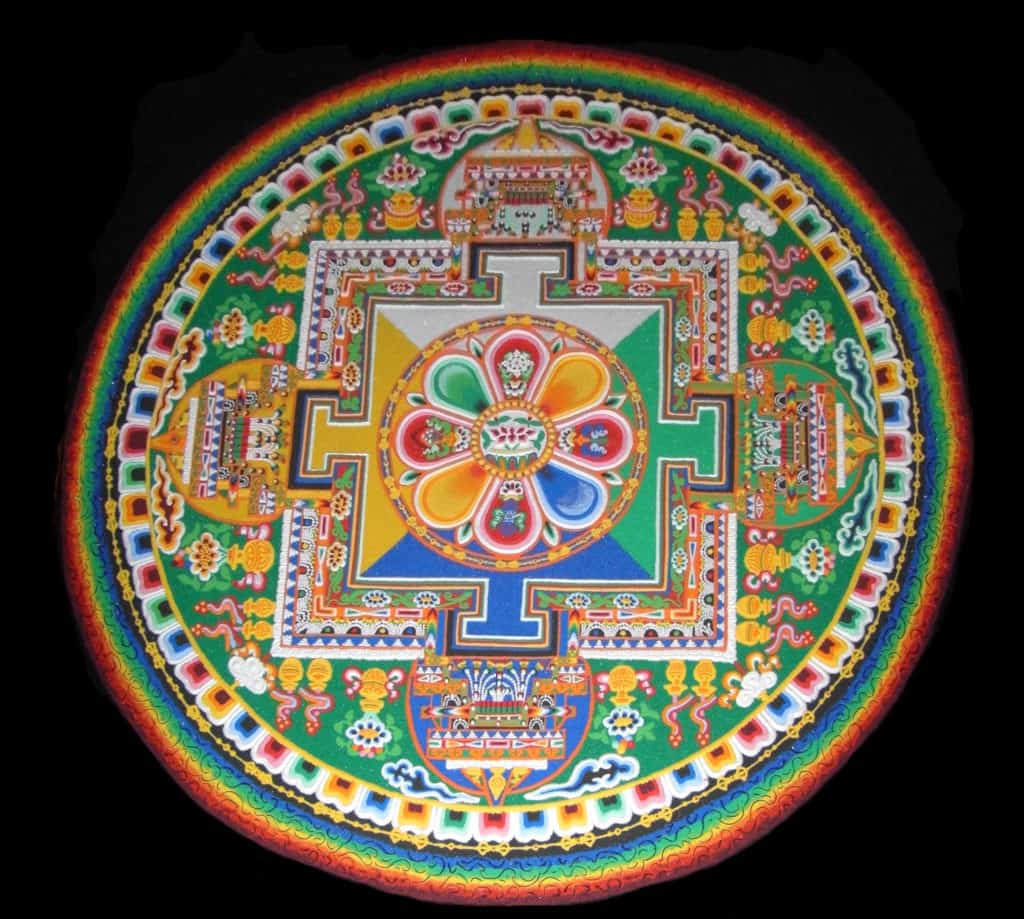Invoking a Wisdom Mandala

By Melissa Moore
A Wisdom Mandala is an ancient meditation tool that depicts the nature of the world and is the representation of a sacred deity. We usually find mandalas shown as colorful circles or squares in Eastern, specifically Tantric Buddhist artwork, as in the painted sand mandalas in Tibet. Each specific color, symbol, and character has a meaning and points to the world's wisdom.
In Karuna, we draw on the Wisdom Mandala of the Five Buddha Families, which has an outer aspect: the five elements of space, water, earth, fire, and wind; an inner aspect, which is the way of emotions; and a secret part, which has to do with transmuting confusion into wisdom. Transmutation is like composting; it means staying with the discomfort of confusion until wisdom dawns.
The Five Buddha Family Mandala arises from Indian Hindu and Buddhist Tantric traditions, as well as the indigenous religion of Tibet, the Bön tradition. All these streams melded together to create Tantric Buddhist teachings or Tibetan Vajrayana Buddhism. Karuna Training draws on this ancient wisdom tradition.
Today, in modern parlance, the word mandala points to the makeup and culture of a group, circle, organization, church, or a like-minded community. Mandala means ‘circle’ in Sanskrit; a circle with a center and circumference. In Buddhist (and Hindu) circles, one can hear the use of the word; “she’s been part of the mandala for many years,” “Let's include him in the mandala,” etc.
In Tibetan Buddhist practices, one finds mandalas representing a practice of a central deity; each deity has its specific powers, qualities, and benefits. A deity often arises in the center of a palace and is surrounded by a retinue of other similarly garbed deities. These retinues are often visualized by the practitioner and sent through the practitioner’s mind to enhance the deities' beneficial power. There is usually a charnel ground outside the palace, where life's blood, gut, and gore (Samsara) are depicted; in Tantric traditions, everything is included on the path of awakening.
Usually, the practitioner uses the depiction of the deity mandala in visualization practice and has a mantra that accompanies the deity. These practices engage one’s body, speech, and mind in the deities' world or mindset, and the practitioner is mixing their mind with the power of the deity - a depiction of their own unlocked divine powers. Visualization practice is an ancient and traditional way of invoking a wisdom mandala in the tradition of Tibetan Vajrayana Buddhism.
Mandalas are also depicted through the art of making intricate sand mandalas, painstakingly constructed by rubbing a mental grated tube full of colored sand and placing the sand in precisely the right place. I’ve tried this method, and it isn’t easy. In the late ’80s, a few Gelukpa monks were engaged at the Deyoung museum in San Francisco, publicly constructing a Sand Mandala over a few weeks. Toward the end of their demonstration, a Muslim woman broke through the crowd, jumped on the table, and scrambled the sand mandala with her feet, screaming, ‘heretics!’ The monks simply stopped and placidly did nothing. When the guards asked if the monks wanted to prosecute the woman, they laughed and said that, ultimately, the sand mandala represents the World’s impermanence. She demonstrated impermanence for everyone. Once we finish, we ritually return the sand to the ocean, so why prosecute?
Deity visualization and constructing sand mandalas are the traditional means of evoking a wisdom mandala. However, Chögyam Trungpa first introduced the Five Buddha Families and Tantra to Westerners as embodied practices and tools to train one’s awareness.
Trungpa evoked the Five Buddha Family Mandala by offering specific postures or physical poses, which one practices in colored rooms or with colored glasses in a retreat setting. The postures intensify one’s awareness of mental and emotional contrasts associated with the Five Buddha Family Mandala. Through the practice of space awareness, he offered an experiential glimpse into one's relationship to space - or perhaps a glimpse into one’s lack of space. Trungpa called this practice Maitri Space Awareness; Maitri is a Sanskrit word meaning loving-kindness.
Space is a big word; it is the elemental birthing place of the Buddha Buddha Family. The element of space, with disturbing emotion, ignorance, and wisdom, is the accommodation of space. Space, in this context, is synonymous with openness and can be sluggish and dull. So space has a challenging manifestation and a liberating one.
By becoming familiar with the Buddha Buddha family of space, one learns to evoke space by becoming aware when we are lacking space. In this way, becoming familiar with the wisdom mandala of the Buddha Families adds elemental daily direction and guidance.
We are invoking the mandala as a way ‘to call on the energies, just like praying or calling on a higher power for guidance. Invoking is a practice of aspiration, meaning we aspire for the wisdom and inspiration to infuse whatever we are drawing to ourselves or a group. Invoking a Wisdom Mandala is something we learn to do in Karuna Training. Once we practice together in retreat, we can call on the energies in our daily life.